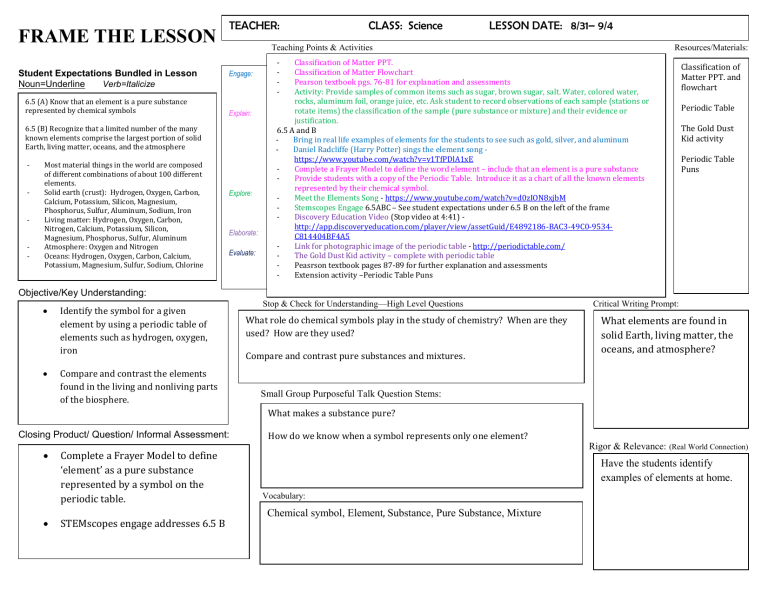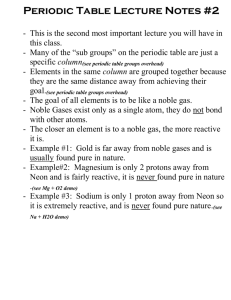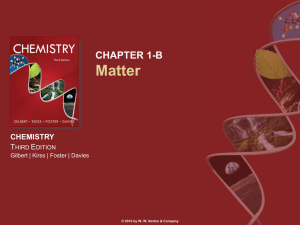6th Science LF Aug 31-Sept 4

FRAME THE LESSON
Student Expectations Bundled in Lesson
Noun=Underline Verb=Italicize
6.5 (A) Know that an element is a pure substance represented by chemical symbols
6.5 (B) Recognize that a limited number of the many known elements comprise the largest portion of solid
Earth, living matter, oceans, and the atmosphere
Most material things in the world are composed of different combinations of about 100 different elements.
Solid earth (crust): Hydrogen, Oxygen, Carbon,
Calcium, Potassium, Silicon, Magnesium,
Phosphorus, Sulfur, Aluminum, Sodium, Iron
Living matter: Hydrogen, Oxygen, Carbon,
Nitrogen, Calcium, Potassium, Silicon,
Magnesium, Phosphorus, Sulfur, Aluminum
Atmosphere: Oxygen and Nitrogen
Oceans: Hydrogen, Oxygen, Carbon, Calcium,
Potassium, Magnesium, Sulfur, Sodium, Chlorine
Objective/Key Understanding:
Identify the symbol for a given element by using a periodic table of elements such as hydrogen, oxygen, iron
Compare and contrast the elements found in the living and nonliving parts of the biosphere.
Closing Product/ Question/ Informal Assessment:
Complete a Frayer Model to define
‘element’ as a pure substance represented by a symbol on the periodic table.
TEACHER: CLASS: Science LESSON DATE: 8/31– 9/4
Engage:
Explain:
Explore:
Elaborate :
Evaluate:
Teaching Points & Activities
Classification of Matter PPT.
Classification of Matter Flowchart
Pearson textbook pgs. 76-81 for explanation and assessments
Activity: Provide samples of common items such as sugar, brown sugar, salt. Water, colored water, rocks, aluminum foil, orange juice, etc. Ask student to record observations of each sample (stations or rotate items) the classification of the sample (pure substance or mixture) and their evidence or justification.
6.5 A and B
- Bring in real life examples of elements for the students to see such as gold, silver, and aluminum
- Daniel Radcliffe (Harry Potter) sings the element song - https://www.youtube.com/watch?v=v1TfPDlA1xE
Complete a Frayer Model to define the word element – include that an element is a pure substance
Provide students with a copy of the Periodic Table. Introduce it as a chart of all the known elements represented by their chemical symbol.
Meet the Elements Song - https://www.youtube.com/watch?v=d0zION8xjbM
Stemscopes Engage 6.5ABC – See student expectations under 6.5 B on the left of the frame
Discovery Education Video (Stop video at 4:41) - http://app.discoveryeducation.com/player/view/assetGuid/E4892186-BAC3-49C0-9534-
C814404BF4A5
Link for photographic image of the periodic table - http://periodictable.com/
The Gold Dust Kid activity – complete with periodic table
Peasrson textbook pages 87-89 for further explanation and assessments
Extension activity –Periodic Table Puns
Resources/Materials:
Classification of
Matter PPT. and flowchart
Periodic Table
The Gold Dust
Kid activity
Periodic Table
Puns
Stop & Check for Understanding—High Level Questions
What role do chemical symbols play in the study of chemistry? When are they used? How are they used?
Compare and contrast pure substances and mixtures.
Critical Writing Prompt:
What elements are found in solid Earth, living matter, the oceans, and atmosphere?
Small Group Purposeful Talk Question Stems:
What makes a substance pure?
How do we know when a symbol represents only one element?
Vocabulary:
Rigor & Relevance: (Real World Connection)
Have the students identify examples of elements at home.
Chemical symbol, Element
,
Substance, Pure Substance, Mixture
STEMscopes engage addresses 6.5 B




